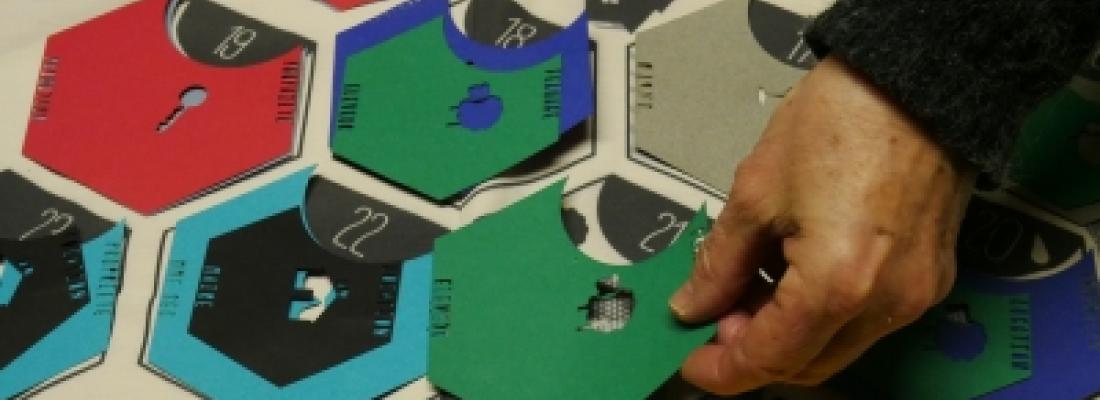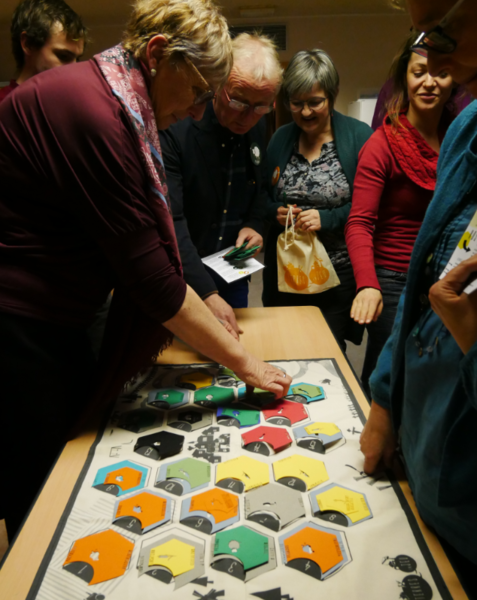Society and regional strategies Reading time 3 min
“Terre en jeu": a training game to support territorial dynamics affecting agricultural land
Published on 29 January 2018

The origins of “Terre en jeu”
Camille designed "Terre en jeu" in the context of her postdoctoral work for the ANR JASMINN Young Researchers project which aims to better understand the conditions required to preserve peri-urban agricultural land. The JASMINN team analysed the social consequences of land policies and identified innovations for the management of peri-urban farmland. Camille surveyed farmers and landowners in two municipalities near Montpellier in order to understand their opportunities for land access, and notably the arrangements they make between each other which avoid a purchase and sale or tenancy (parol lease, etc.).
In parallel with scientific publications, she decided to present her findings to a broader audience, including the uninitiated, at the International Festival of Geography in St Dié (Vosges). She imagined and implemented a role game that recreates negotiations between farmers, landowners, the local mayor and property developers (the players) to obtain access to agricultural land. The interest aroused by her game encouraged her to take it further: “I realised that the game could be useful to my research. I thus set myself the goal to analyse the feelings of players regarding unequal access to agricultural land (feelings of injustice). Secondly, I was asked by teachers and development agents to come and lead the game in the classroom or in their territory, thus proving that it was meeting a need.”
Today, this game is protected by an invention disclosure within INRA. Camille designed it in the context of the JASMINN project, notably with Coline Perrin and Pascal Thinon, who are the co-authors alongside Camille because of their contributions to the player profiles and game development. As the main author, Camille Clément is keen to emphasise that as well as the declared authors of the game, other members of the JASMINN project were of considerable assistance to her.
How is it played?

“Terre en jeu” (Land in Play) is thus a role game organised around a board which represents a municipality with a village at its centre and farmland around it. For the moment, the number of players is limited to ten (or 20 if they play in pairs). Four farmer profiles are represented (a winegrower, cereal farmer, livestock breeder and market gardener) and four landowner profiles (a major landowner, an old lady who wishes to sell her land, a retired winegrower and a newcomer to the municipality). There is also a mayor and a property developer who wishes to purchase suitable land in the municipality.
In four rounds, each lasting seven minutes, the players must attain the objectives they have been set on their player cards. The farmers will try to expand or set themselves up, and the owners will aim to make money or acquire new land, etc. To achieve this, the players can sell or purchase plots of land, but also rent them, either in the long term (a tenancy and contract cannot be broken during the game) or in the short term (a contract that can be called into question during each round). At the end of the game, a vote is taken on the PLU (Local Planning Regulations) which were not fixed until then. The mayor then determines the plots that can be built on, and once again puts him or herself forward for election, as he or she must be re-elected to attain his or her goals.
The game ends with a debriefing when the players can look back at the strategies they developed and their consequences with respect to the agricultural development of the municipality. This debriefing offers an opportunity to consider the concepts of waiting for land, the development of fallow, ground rent, speculation, the role of the PLU and that of the community in a municipality. When she leads the game, Camille always points out the liberties that can be taken during play with respect to reality (simplifications for the needs of the game). The aim is to establish links between the fictitious situation and the reality in different regions. Thus the game makes it possible to consider how the market for peri-urban agricultural land functions if the game is implemented in the context of training, or to imagine projects and development solutions if the game is implemented in a region.
One of the specific features of this game is indeed that it can be used during both initial training (agricultural school, training in geography) and continuing training (of regional technicians or elected representatives, for example), as well as in the context of implementing or designing regional development projects.
They have tested it for you
Camille tested the game at the FIG, during the annual seminar for the JASMINN project, and then with her friends and colleagues. This enabled improvements to certain elements and tested three successive versions of the game. After one of these tests, a designer friend offered to design the game, which markedly improved it from an ergonomic point of view. “After my presentation at the FIG in 2016 (on the theme of: Is the world moving faster?), a development agent from the Rural Foundation for Wallonia (Samois-Ardennes team) asked me to implement the game in his region, in order to revive agricultural projects there.”
Several other presentations then followed:
- Camille was asked by Françoise Jarrige and Frederic Viard, lecturers respectively at SupAgro Montpellier and PolyTech to lead "Terre en Jeu" with students,
- She implemented the game in three regions : an association with plans for an eco-hamlet near Montpellier, an association of municipalities (Avants-Monts) near Pézenas (South of France) and the “Pays Serre-Ponçon, Ubaye, Durance” of the Southern Alps
- And Coline Perrin has used the game in the context of a Master’s degree course in geography in Bordeaux.
The very positive feedback received following these sessions has encouraged further development of the game.
The promising future of role games
During her Master’s degree, Camille was trained in role games as a regional development tool. Her interest in this method led her to try and develop a game in her research that would have a longer life than those she had an opportunity to study or test, which usually only lasted for the duration of a project or thesis. “Terre en Jeu” is now a tool for research and generic training that can be implemented in a variety of regions and training courses.
“I hope it will have a longer life and that I will participate in its future. To ensure this, I and my colleagues in the Agricités collective in the UMR Innovation have initiated a pre-maturation project in order to develop it and evaluate the feasibility of creating an independent entity focused on its management and dissemination, as well as the creation of other similar tools. I have just learnt that this project, called FONCIJEU, will be funded by the Occitanie Region for a one-year period, which will allow me to continue working in the UMR Innovation and to pursue its development (creation of new players, new boards, etc.). I am therefore looking forward to being able to disseminate the use of this new training and regional management tool!”
